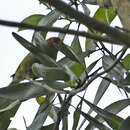Biology
provided by Arkive
The akepa is principally found high up in the forest canopy, where it forages for invertebrates amongst twigs, crevices and, in particular, the leaf and flower buds of the ohia tree. Using its unusual, crossed bill tips, it pries open the buds, extracting caterpillars and spiders (2) (3) (4) and sweeping out nectar with the brush-like tip of its tongue (3).
The reproductive behaviour of the akepa is relatively complex, with the juvenile males engaging in pre-breeding periods of competition, lasting from October to March, for a number of years before finally breeding. Competitive activities include chases, group displays and stunning aerial “dogfights” in which rival males may soar together up to 100 metres into the air before separating. The males compete for the opportunity to form long-term breeding pairs with females possessing the brightest yellow-orange patches. These females are more likely to raise chicks successfully than duller females of the same age, but are much less abundant (3).
Nest building occurs from early March to late May, with the female locating a suitable tree cavity in which a clutch of one to three eggs is laid. During incubation, the male provides food for the female, and, once hatched, contributes to the feeding of the chicks as well. Fledging occurs from early April to late June, with the fledglings remaining with their parents until September or October, at which point they join foraging flocks (3).
Conservation
provided by Arkive
Listed as Endangered by the U.S. Fish and Wildlife Service in 1970, the akepa was one of the species targeted in the 1982 Hawaii Forest Bird Recovery Plan, leading to the improved protection and management of its habitat (3). A number of protected areas currently support akepa populations, in particular, Hakalau Forest National Wildlife Refuge, which contains large numbers. Within these areas, reforestation efforts are helping to restore this species' habitat in the long-term, while artificial nesting boxes are providing a promising short-term benefit to the akepa's survival (2) (3).
Unfortunately, there are no simple solutions to the threat of disease. Wiping out introduced mosquitoes does not appear to be feasible and, therefore, the only solution may be to try and find disease-resistant akepa individuals which can be selectively bred and distributed amongst the wild populations (3). While it is hoped that such efforts will preserve the akepa in the wild, should its population crash, captive breeding programs have been established to ensure that this fascinating species is prevented from disappearing forever (2) (3).
Description
provided by Arkive
Superficially resembling a finch, the akepa is diminutive species which is remarkable for its unusual bill, the tips of which are misaligned due to the lower part curving slightly to the side (2) (3). The male undergoes a lengthy and significant change in plumage colour over the course of its development. In its first and second year, the juvenile male is mainly greyish-green and resembles the adult female, but by its third year it develops a bright orange head and a dull brownish-orange body. Finally, in its fourth year it obtains the full mature colouration (4) (5), with arresting bright red-orange plumage over its entire head and body, except on the wings and tail which are dark brown or black (2) (6). Although the female mostly remains a dull greyish-green throughout its development, the adult female does obtain yellow-orange patches on the breast, throat and head, which become increasingly bright with age (3). The akepa's vocalisations vary from a slow trilling song to a characteristic call, cheedle-ee (2).
Habitat
provided by Arkive
Historically common throughout Hawaii Island, today the akepa is restricted to forests at elevations between 1,300 and 2,100 metres (3). This species is totally reliant on the presence of large mature trees with naturally occurring cavities for nesting, favouring forests composed of ohia (Metrosideros polymorpha) (2), or a mix of ohia and koa (Acacia koa) (3).
Range
provided by Arkive
While today, the only surviving akepa population is that of the subspecies Loxops coccineus coccineus on Hawaii Island, additional subspecies of akepa were previously found on Oahu and Maui (2) (3). The Oahu subspecies has been extinct for over 50 years (4), but the Maui subspecies disappeared more recently, with the last sighting in 1988 (2).
Status
provided by Arkive
Classified as Endangered (EN) on the IUCN Red List (1).
Threats
provided by Arkive
With its dependence on large, mature trees, the extensive forest clearance that has occurred on Hawaii has had a catastrophic effect on the akepa. Not only have significant numbers of mature trees been lost to logging, but the remaining exposed trees have become more vulnerable to windfall. Despite reforestation efforts, the planted trees take decades to develop natural cavities, and cannot possibly provide the akepa with nesting habitat fast enough to offset its rapid population decline (2) (3).
A further threat to this species is the introduction of non-native predators and disease-carrying mosquitoes to Hawaii. The mosquitoes transmit avian malaria and avian pox, to which the previously unexposed akepa lacks any resistance. As a result, its population has become restricted to elevations above 1,300 metres, where the cooler temperatures prevent the mosquitoes' survival. Nevertheless, as global climate change causes temperatures to rise, the disease is likely to spread to these higher elevations (3).

